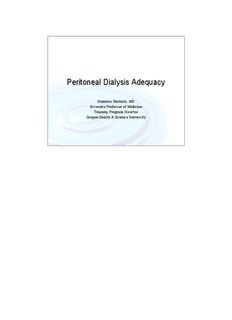
Peritoneal Dialysis Adequacy - ISPD.org PDF
Preview Peritoneal Dialysis Adequacy - ISPD.org
Peritoneal Dialysis Adequacy Suzanne Watnick, MD Associate Professor of Medicine Training Program Director Oregon Health & Science University Outline of Talk What is Adequacy (Definition)? What do the current guidelines say? What basic literature is important? How do we practically assess adequacy? Case to illustrate the issues… • Mr H is a 37 yo caucasian gentleman, ESRD x 4 years due to T1 DM since age 2 – He chose PD because he still works full time – Gastroparesis is his biggest complaint • He stopped his midday exchange x 1 mo • Insists he feels better: nausea, better appetite – Regimen: 4 x 2.0L nighttime exchanges of 1.5% Dianeal; final fill and midday exchange 1.5L of 2.5% Dianeal Case continues • The renal fellow gets all the appropriate information, and tells Mr H that he should not have stopped his daytime exchange. • Is the fellow correct? • Is Mr H receiving adequate dialysis? • What is adequacy? What is Adequacy? Active learning exercise: – How would you define adequacy in terms of replacing renal function? In nephrology, adequacy first used to describe an appropriate dose of hemodialysis (HD)* – Adequacy for peritoneal dialysis adopted later – Conceptual overall goal equivalent to HD, calculations not equivalent** *Frank Gotch introduced the concept of adequacy of dialysis whenhe proposed the ‘Urea Clearance’concept as a measure of dialysis efficacy. ‐personal communication, George Porter, MD **In HD, Kt/V equation is used to account for the fall in efficiency as urea concentrations diminish during the HD session. Note the logarithmic (ln) term : Kt/V (HD) = ‐ln(R‐.008xt)+(4‐ 3.5xR)x0.55UF/W In CAPD, this fall in efficiency does not happen –Kt/V relates to the actual mass of urea removed. This means that Kt/V cannot be compared between HD and PD since they are different measures which happen to share the same name. 5 Adequacy Algorithm Input patient’s • S/ subjective well-being Input objective measures • O/ of renal replacement therapy and daily living • A/ Are goals Ye No being achieved s • P/ Continue what you are doing Change something Adequacy: the ability of a treatment plan (i.e., dialysis) to meet the needs and demands of the system (i.e., the body) at all times to maintain satisfactory (if not optimal) performance in the steady state (i.e., more than a minimal Kt/V). 6 What contributes to Adequacy? Broad sense Control of: Possibly most important: – Acid-base status How the patient feels! – BP and volume status – Cardiovascular Risk – Diet/nutrition – Mineral/Bone disorders – Small/middle molecules Adequacy is a concept, not a number, and includes more than the issues listed above. 7 What contributes to Adequacy? Narrow Sense: – Appropriate small molecular weight solute clearance – Specifically measured as urea clearance • In PD, you measure Kt/V = Renal Kt/V + total Dialysate Kt/V • Renal ≠ Dialysate Kt/V but this is how it is practically calculated Fun fact: Urea was discovered by Hilaire Rouelle in 1773. It wasthe first organic compound to be artificially synthesized from inorganic starting materials, in 1828 by Friedrich Woehler. 8 Adequacy: Guidelines KDOQI Guidelines Minimal ‘delivered’ dose • Total Kt/V AT urea LEAST 1.7 per week. • sum of peritoneal and renal urea clearance • Caveat: If urine output > 100cc/day, collection should be performed. KDOQI = Kidney Disease Outcomes Quality Initiative, sponsored bythe National Kidney Foundation (NKF) 9 Adequacy: Guidelines ISPD Recommendations 1.7 is – Adequacy should be interpreted clinically rather than via solute and fluid Floor removal – For small solute removal, total (renal + peritoneal) Kt/V not Not urea less than 1.7 at any time – If pt relies on residual renal function to achieve adequacy, monitor q1-2mo if able, but no less than q4-6 mo ISPD = International Society of Peritoneal Dialysis Lo WK et al, Peritoneal Dialysis International 26:520, 2006 The Guidelines are much more extensive than what is listed here.Please refer to article for further information. 10
Description: